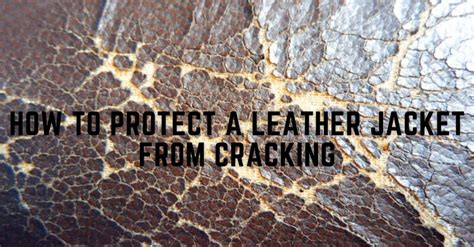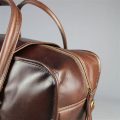How to Prevent Leather From Cracking: A Comprehensive Guide
Leather is a beautiful and durable material that can last for many years with proper care. However, over time, leather can become dry and cracked, especially if it’s exposed to harsh elements or not properly cared for. This can make your leather goods look old and worn and can even damage the material itself. In this comprehensive guide, we’ll explore the common causes of leather cracking and provide practical tips to prevent it, ensuring your leather items stay in top condition.
What Causes Leather to Crack?
Leather cracking is often a result of a combination of factors, but the primary cause is dryness. Leather is made from animal hides, and these hides contain natural oils that keep the material supple and flexible. Over time, these oils can deplete, leading to dryness and cracking. The following factors can contribute to leather cracking:
- Exposure to sunlight and heat: UV rays from sunlight and excessive heat can dry out leather and cause it to become brittle and crack.
- Humidity fluctuations: Exposure to both high and low humidity can affect the moisture content of leather, leading to cracking.
- Lack of proper conditioning: Regular conditioning helps replenish natural oils and keep leather hydrated, preventing cracking.
- Improper storage: Storing leather in airtight containers or in areas with excessive moisture can trap humidity, leading to cracking.
- Abrasion and wear: Constant friction, scratching, or rubbing can damage the leather’s surface and contribute to cracking.
Understanding these causes is crucial to preventing leather cracking. By implementing the right preventive measures, you can keep your leather items looking their best for years to come.
How to Prevent Leather from Cracking: Practical Tips
Now that we know the culprits behind leather cracking, let’s dive into practical tips to prevent this problem:
1. Condition Regularly
Regular conditioning is the cornerstone of leather care. Conditioners replenish the natural oils lost over time, keeping leather supple and preventing cracking. Here’s a step-by-step guide on how to condition leather:
- Choose the right conditioner: Opt for a high-quality leather conditioner specifically formulated for the type of leather you’re working with. Different leather types require different conditioners. For example, aniline leather is more delicate and requires a lighter conditioner compared to oil-tanned leather.
- Prepare the leather: Clean the leather thoroughly to remove dirt, dust, and any accumulated grime. You can use a damp cloth and a mild soap solution for this purpose.
- Apply the conditioner: Using a soft cloth, apply a thin and even layer of conditioner to the leather. Avoid over-applying, as this can leave a greasy residue.
- Buff the leather: After applying the conditioner, use a clean and dry cloth to buff the leather gently. This helps distribute the conditioner evenly and enhances the leather’s shine.
- Let it dry: Allow the leather to dry completely before using the item. Drying time may vary depending on the conditioner and leather type.
Conditioning frequency varies depending on leather usage and the type of leather. A good rule of thumb is to condition leather goods every 3-6 months, especially for frequently used items.
2. Avoid Direct Sunlight and Heat
Leather is sensitive to UV rays and extreme heat. Prolonged exposure to these elements can dry out the leather, making it brittle and susceptible to cracking. Here’s how to protect your leather items:
- Store leather items indoors: Avoid leaving leather items exposed to direct sunlight for extended periods. Store them in a cool, dry place indoors, away from heat sources like radiators and fireplaces.
- Use leather protectors: Leather protectors create a barrier that shields the leather from harmful UV rays and other environmental aggressors. Apply a leather protector regularly, especially for items frequently exposed to sunlight.
- Protect car interiors: Car interiors are often exposed to extreme temperatures. Consider using leather seat covers or protectants to shield your leather seats from damage.
- Cover outdoor furniture: If you have leather furniture in your garden, cover it with a waterproof cover during harsh weather conditions to protect it from rain, sun, and dust.
3. Control Humidity Levels
Maintaining consistent humidity levels is important for leather health. Both excessive dryness and excessive humidity can negatively impact leather. Here are some tips:
- Use a humidifier in dry climates: If you live in a dry climate, use a humidifier to add moisture to the air and prevent leather from drying out.
- Store leather in a cool, dry place: Avoid storing leather in damp or humid environments. Store leather items in a cool, dry place with good ventilation.
- Consider using silica gel packets: Silica gel packets absorb moisture and can be placed in storage containers to help control humidity levels.
4. Protect from Abrasion and Wear
Leather can be easily scratched or abraded, which can lead to cracks. Here’s how to prevent this:
- Handle leather with care: Be gentle when handling leather items. Avoid dragging them on rough surfaces or exposing them to sharp objects.
- Use leather protectors: Leather protectors form a protective barrier against scratches and abrasion. Apply them regularly to vulnerable areas like leather jackets or bags.
- Store items separately: When storing multiple leather items, separate them to prevent rubbing and wear.
Can You Repair Cracked Leather?
While prevention is key, sometimes leather cracks despite your best efforts. If you find yourself with cracked leather, it’s not always a lost cause. You can try repairing it using several methods.
- Leather filler: Leather fillers are designed to fill in cracks and scratches. They come in different colors and can be matched to your leather. Apply a thin layer of filler to the crack, let it dry, and then sand it smooth.
- Leather dye: If the crack is deep, you can use a leather dye to color the surrounding leather to match the repair.
- Leather patch: For larger cracks or tears, you can use a leather patch to cover the damaged area. Choose a patch that matches the leather in color and texture.
Remember, repairing leather cracks requires skill and patience. If you’re unsure about the repair process, it’s best to consult a professional leather repair specialist for best results.
How to Maintain Leather After Repair
Once you’ve repaired cracked leather, it’s important to maintain it properly to prevent further damage.
- Continue regular conditioning: Keep the leather moisturized by conditioning it regularly to prevent further drying and cracking.
- Protect from harsh elements: Continue to shield the leather from direct sunlight, heat, and humidity to prevent further deterioration.
- Handle with care: Be mindful of handling the repaired area and avoid rubbing or applying excessive pressure.
By following these steps, you can help extend the lifespan of your repaired leather items and keep them looking their best.
Types of Leather and Their Care Requirements
Different types of leather require different care methods. Understanding the specific needs of your leather type will help you tailor your care routine for optimal results.
1. Full-Grain Leather
Full-grain leather is the most durable and luxurious type of leather. It has a natural grain pattern and a smooth, consistent surface. Full-grain leather requires regular conditioning to maintain its softness and prevent cracking.
2. Top-Grain Leather
Top-grain leather is a less expensive alternative to full-grain leather. It’s created by removing the top layer of the hide, resulting in a more uniform surface. Top-grain leather can be more susceptible to cracking, so it’s crucial to condition it regularly.
3. Aniline Leather
Aniline leather is a highly breathable and luxurious type of leather. It’s finished with a minimal amount of dye, which allows the natural grain pattern to shine through. Aniline leather is sensitive to water and stains, so it requires gentle cleaning and conditioning.
4. Nubuck Leather
Nubuck leather is a type of suede that has a velvety feel. It’s known for its softness and breathability. Nubuck leather requires careful cleaning and conditioning to maintain its texture. Use a specialized nubuck cleaner and conditioner to avoid damaging the delicate surface.
5. Patent Leather
Patent leather is a type of leather that’s coated with a glossy sealant. It’s often used for shoes and handbags. Patent leather is more resistant to water and stains than other types of leather but can still crack if not properly cared for. Condition it regularly with a leather conditioner specifically designed for patent leather.
FAQs
Can I use petroleum jelly to condition leather?
While petroleum jelly can temporarily moisturize leather, it’s not recommended for long-term conditioning. Petroleum jelly can clog the pores of the leather, preventing it from breathing and potentially leading to damage over time. Opt for a leather-specific conditioner for best results.
How often should I condition leather?
The frequency of conditioning depends on the type of leather, how often it’s used, and the environment it’s exposed to. A good general guideline is to condition leather items every 3-6 months, especially for frequently used items.
What are the best leather conditioners?
There are many excellent leather conditioners available on the market. Some popular brands include Leather Honey, Bickmore Bick 4, and Saphir Medaille d’Or. Choose a conditioner specifically formulated for the type of leather you’re working with.
Can I use a shoe polish to condition leather?
Shoe polish is designed to add shine and protect leather, but it’s not a substitute for a leather conditioner. Shoe polish can clog the pores of the leather and prevent it from breathing, potentially leading to damage over time.
Can I use a hair conditioner on leather?
It’s not recommended to use hair conditioner on leather. Hair conditioners are formulated for human hair and may contain ingredients that can damage leather.
What’s the best way to clean leather?
You can clean leather with a damp cloth and a mild soap solution. Avoid using harsh chemicals or abrasive cleaners, as these can damage the leather.
How can I prevent leather from getting wet?
To protect leather from getting wet, you can use a waterproof spray. Avoid exposing leather items to rain or water whenever possible. If leather does get wet, dry it promptly with a soft cloth and avoid direct heat.
Summary of Leather Care
Caring for leather requires a proactive approach. By understanding the causes of cracking and implementing the right preventive measures, you can significantly extend the lifespan of your leather items. Regularly condition your leather, protect it from harsh elements, and handle it with care. Remember, a little effort goes a long way in maintaining the beauty and longevity of your treasured leather goods.
Table: Leather Care Tips
| Leather Care Tip | Description |
|---|---|
| Regular Conditioning | Replenish natural oils to keep leather supple and prevent cracking. |
| Avoid Direct Sunlight and Heat | Protect leather from UV rays and excessive heat to prevent dryness and brittleness. |
| Control Humidity Levels | Maintain consistent humidity to prevent leather from becoming too dry or too moist. |
| Protect from Abrasion and Wear | Handle leather with care and use protectors to shield it from scratches and rubbing. |
| Store Leather Properly | Store leather in a cool, dry place with good ventilation, avoiding direct sunlight and heat. |
| Clean Leather Regularly | Remove dirt and grime with a damp cloth and mild soap solution. Avoid harsh chemicals. |
| Repair Cracks Promptly | Address cracks as soon as they appear to prevent them from worsening. |


